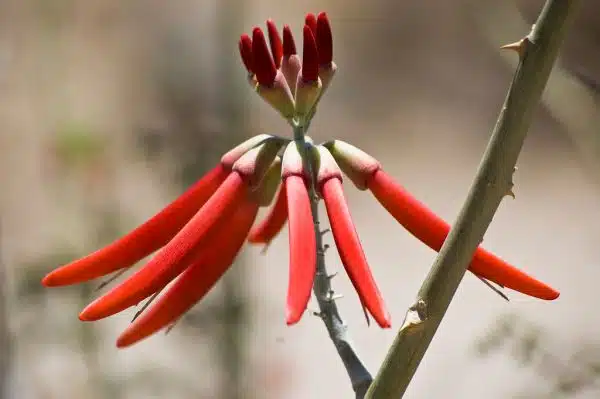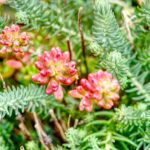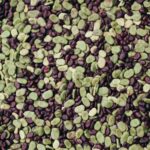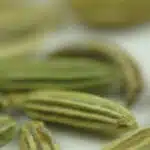The Coral Bean, scientifically known as Erythrina herbacea, is a beautiful flowering plant that belongs to the Fabaceae family. This plant is native to the southeastern region of the United States and can thrive in various soil types, making it a popular choice for gardening enthusiasts. Due to its vibrant red flowers and foliage, the Coral Bean is often used as an ornamental plant in gardens and landscape designs.
In this article, we will discuss how to grow and care for the Coral Bean, including its ideal growing conditions, planting techniques, watering and fertilizing needs. Whether you are a seasoned gardener or a beginner looking to add some color to your garden, this guide will provide you with all the necessary information to successfully grow and care for this stunning plant. So let’s dive in!
Introduction To The Coral Bean Plant
The Coral Bean plant is a fascinating and unique addition to any garden or landscape. With its vibrant red flowers and interesting seed pods, it is sure to catch the eye of any passerby. However, this plant offers more than just aesthetic appeal. The benefits of the Coral Bean extend beyond its appearance.
One of the most notable benefits of the Coral Bean is its ability to attract pollinators such as bees and hummingbirds. These creatures are essential for maintaining a healthy ecosystem, and the Coral Bean plays an important role in supporting their populations. Additionally, the Coral Bean has been used in traditional medicine for centuries due to its potential healing properties.
Aside from its benefits, the Coral Bean also boasts several unique features that make it stand out among other plants. Its seed pods are large and eye-catching, resembling beans or even rattlesnakes depending on the variety. The plant is also able to thrive in a variety of environments, including both wet and dry soils. Understanding how to care for this plant is crucial in order to reap its benefits and fully appreciate its unique characteristics.
Understanding The Coral Bean’s Growing Requirements
The coral bean is a beautiful plant that produces vibrant red flowers that attract pollinators. It is also known as the Cherokee bean, and it is native to the southeastern United States. Growing and caring for this plant requires some level of expertise, but with the right guidance, it can be an enjoyable experience.
Coral bean propagation is best done through seeds or by taking cuttings from an established plant. The seeds should be soaked in water for at least 24 hours before planting to improve their chances of germinating. Cuttings should be taken from healthy branches during the early spring and planted in well-draining soil. Propagation takes time and patience, but it’s a rewarding process that ensures you have a steady supply of coral beans.
Overcoming coral bean growing challenges requires proper care and attention to detail. Coral beans prefer well-draining soil that’s slightly acidic with a pH range of 6 to 7.5. They also require regular watering during dry spells and protection from frost during winter months. Coral beans are susceptible to fungal diseases, which can be prevented by pruning diseased branches and watering them from below instead of overhead.
Choosing the right location for planting is crucial for coral bean growth success. They prefer full sun to partial shade conditions, making them ideal for gardens or patios that receive ample sunlight throughout the day. When choosing a location, ensure there’s enough space between plants for proper air circulation and avoid areas prone to flooding or standing water accumulation. With these tips on how to grow and care for coral beans, you’ll have a beautiful addition to your garden in no time!
Choosing The Right Location For Planting
The coral bean plant thrives in locations that provide ample sunlight exposure. Ideally, it should be planted in an area where it can receive at least six hours of direct sunlight per day. If the plant does not get enough sunlight, it may become weak and vulnerable to pests and diseases. Therefore, it is crucial to choose a location that receives plenty of sunshine.
When selecting a location for planting, you should also consider the soil quality. Coral beans grow well in soil that is well-draining and fertile. The soil should have a pH level between 6.0 and 7.5, which is slightly acidic to neutral. If the soil is too alkaline or too acidic, the plant may struggle to absorb nutrients from the soil, resulting in stunted growth or yellowing of leaves.
It is important to prepare the planting site before introducing coral bean plants into the area. This involves removing any weeds or debris from the planting bed and loosening up compacted soil to encourage root growth. You can also amend the soil with organic matter such as compost or aged manure to improve its fertility and texture. By choosing an appropriate planting location and preparing the soil adequately, you can help ensure that your coral bean plants will grow strong and healthy for years to come.
To further optimize growth conditions for your coral bean plants, you need to take additional steps in preparing their environment by providing adequate water supply while avoiding overwatering them as well as effectively managing pests and diseases threats; these shall be discussed in subsequent sections below.
Preparing The Soil For Optimal Growth
- Soil pH is an important factor to consider when determining the optimal growing conditions for the coral bean (Erythrina herbacea).
- An ideal soil pH level for the coral bean is 6.0-7.5, as too low or too high of a pH can negatively affect the plant’s growth.
- Soil nutrients play a large role in the overall health of the coral bean. The soil should have an adequate amount of nitrogen, phosphorus, and potassium.
- Compost and organic matter should be added to the soil to ensure the coral bean has sufficient nutrition for optimal growth.
Soil Ph
To ensure optimal growth of coral beans, it is important to take into consideration the soil pH. Coral beans require a slightly acidic soil with a pH range of 6.0 to 7.5 for optimal growth. This is because an acidic soil allows better nutrient uptake by the roots and improves water retention, which are both crucial for the plant’s growth and development.
On the other hand, an alkaline soil can lead to stunted growth and yellowing of leaves due to nutrient deficiencies. In such cases, amending the soil with organic matter such as compost or peat moss can help to lower the pH level to within the recommended range. It is also important to avoid adding lime or other alkaline materials that can raise the pH level further.
In addition, testing the soil pH periodically using a home test kit or sending samples to a laboratory can help determine if any adjustments need to be made. By ensuring that coral bean plants receive the appropriate soil pH, gardeners can promote healthy growth and vibrant blooms in these beautiful plants.
Soil Nutrients
After discussing the importance of soil pH in the previous subtopic, another crucial aspect to consider when preparing the soil for optimal growth is its nutrient content. Soil nutrients play a significant role in providing plants with essential elements necessary for their growth and development. Plants require various macronutrients such as nitrogen, phosphorus, and potassium, as well as micronutrients such as iron, zinc, and magnesium.
The composition of soil can greatly affect its nutrient content. Sandy soils tend to have lower nutrient levels due to their loose texture that allows nutrients to leach out quickly. In contrast, clay soils hold onto nutrients tightly but may also lead to poor drainage and root rot if overwatered. Loamy soils are considered ideal for growing plants as they provide a balance between water retention and drainage while also containing sufficient amounts of nutrients.
To determine the nutrient content of the soil, gardeners can conduct a soil test that measures levels of different macronutrients and micronutrients. The results of the test can help identify any deficiencies or excesses in certain elements and guide gardeners on how to amend the soil accordingly using fertilizers or organic matter such as compost or manure.
In conclusion, understanding soil composition and pH levels are important when preparing the soil for optimal plant growth, but it is just as crucial to ensure that it contains sufficient amounts of nutrients needed by plants. By conducting regular soil tests and amending accordingly, gardeners can provide their plants with all they need for healthy growth and development.
How To Plant Coral Bean Seeds Or Seedlings
Proper preparation of the soil is crucial for optimal growth of the coral bean. This plant prefers well-draining soil that is rich in organic matter. You can achieve this by adding compost or well-rotted manure to the soil before planting.
Once you have prepared the soil, it’s time to start growing your coral bean. Starting indoors is a great option because it allows you to control the germination process and ensure that your seedlings are strong enough to withstand transplanting. Sow one or two seeds per pot, and keep them moist until they germinate. Once they have sprouted, place them in a sunny location where they can receive at least six hours of sunlight per day.
When your coral bean seedlings have grown large enough to handle, it’s time to transplant them into their permanent location. Choose a spot that receives full sunlight and has well-draining soil. Dig a hole that is slightly larger than the root ball of your seedling, and gently place it in the hole. Backfill with soil, and water thoroughly to help settle the soil around the roots.
As your coral bean grows, it will require regular watering and fertilizing for healthy growth. In the next section, we will discuss some watering and fertilizing techniques that you can use to ensure that your plant thrives in its new home.
Watering And Fertilizing Techniques For Healthy Growth
Proper watering and fertilizing techniques play a crucial role in the healthy growth of coral beans. To ensure optimal growth, it is essential to water them frequently and in the right quantity. Coral beans require regular watering, especially during the growing season, which falls between spring and fall. The frequency of watering should be increased during periods of prolonged drought or high temperatures.
Choosing the right fertilizer is also important when caring for coral beans. A well-balanced fertilizer that includes nitrogen, phosphorus, and potassium will help promote healthy growth. However, it is crucial to avoid fertilizers that contain too much nitrogen as they can cause excessive leaf growth at the expense of flower production. It is recommended to apply a slow-release fertilizer once every three months during the growing season.
In addition to proper watering and fertilization, pruning and other maintenance practices are necessary for maintaining healthy coral beans. Pruning not only helps control their size but also encourages more vigorous blooming. Deadheading spent flowers regularly will help promote continuous blooming throughout the growing season. Additionally, removing any damaged or diseased branches will prevent further spread of diseases and pests that may harm your plants.
Pruning And Maintenance Tips For The Coral Bean
Pruning is a necessary part of coral bean maintenance, as it reduces the size of the plant and encourages a compact and attractive form. Watering should be done frequently, though not excessively, to ensure adequate moisture for the plant. Fertilizing should be done regularly to provide essential nutrients, while mulching helps to maintain soil temperature and moisture levels. Finally, proper soil preparation and drainage are essential for optimal coral bean growth and should be monitored regularly.
Pruning
Pruning is an essential part of maintaining the health and beauty of the coral bean. The techniques employed in pruning must be done correctly to ensure the plant does not suffer from any damage. One technique involves removing dead or diseased branches, which can be done at any time of year. However, it’s best to avoid pruning during winter as this may damage the new growth.
Another technique involves shaping the plant by pruning back branches that are too long or crossing over other branches. This should be done during late winter or early spring before new growth appears. It’s important to make clean cuts using sharp tools to prevent tearing or damaging the bark. Be sure to cut just above a leaf node or bud to encourage new growth.
Timing is critical when it comes to pruning coral beans. Pruning at the right time will help maintain its shape and promote healthy growth, while improper timing can lead to stunted growth and reduced flowering. With proper pruning techniques and timing, you can keep your coral bean vibrant and healthy for years to come.
Watering
In addition to pruning, watering is also a crucial aspect of maintaining the health and beauty of the coral bean. These plants require moderate watering, with frequency depending on the soil moisture levels. Overwatering can lead to root rot and other issues, while underwatering can cause stunted growth and reduced flowering.
To determine when to water your coral bean, check the soil moisture level by sticking your finger about an inch into the soil. If it feels dry, it’s time to water. However, if the soil feels moist, wait a few more days before checking again. It’s important not to let the soil become too dry or too wet for extended periods as this can negatively impact the plant’s health.
When watering your coral bean, make sure to soak the soil thoroughly but avoid letting water pool around the base of the plant. This can lead to fungal diseases and other issues. By providing proper watering and monitoring soil moisture levels, you can help ensure that your coral bean stays healthy and vibrant for years to come.
Common Pests And Diseases To Watch Out For
After pruning and maintenance, it’s important to keep an eye out for common pests and diseases that can affect the coral bean. One of the most prevalent problems is spider mites, which can cause discoloration and defoliation of the plant. Regularly misting the foliage with water can help prevent spider mites, as they prefer dry environments. Additionally, introducing natural predators like ladybugs or lacewings can be an effective prevention method.
Another pest to watch out for is aphids, which feed on the sap of the plant and can cause deformation and stunting of growth. Natural remedies like spraying a mixture of water and dish soap onto affected areas or introducing beneficial insects like ladybugs or parasitic wasps can help control aphid populations. In terms of diseases, root rot is a common problem that can be caused by overwatering or poor soil drainage. To prevent this issue, ensure that the soil is well-draining and avoid excessive watering.
To ensure a successful harvest of coral bean seeds, it’s important to properly store them after harvesting. Once collected from the plant pods, allow the seeds to dry completely in a cool, dry location before storing in an airtight container. It’s also important to label the container with information about the seed variety and date of collection. By following these simple steps, you’ll be able to enjoy healthy coral bean plants for years to come.
Harvesting And Storing Coral Bean Seeds
After the coral bean plant has bloomed, it is time to harvest the seeds. The seeds are contained in a long pod that turns brown as it matures. It is important to wait until the pods have dried completely before harvesting. Once the pods are dry, they can be collected by hand or with pruning shears. It is essential to wear gloves when handling the pods, as they contain toxic compounds.
Seed germination of coral bean is relatively easy and can be done using propagation techniques such as scarification or stratification. Scarification involves scratching or nicking the seed coat to allow water to penetrate more easily. Stratification, on the other hand, involves exposing the seeds to cold temperatures for a period of time before planting them in soil. This process mimics natural conditions that occur during winter and encourages germination in spring.
Creative ways to use harvested coral bean seeds include crafting items such as jewelry, ornaments, and decorations. The vibrant red color of the seeds makes them visually striking and attractive for artistic purposes. Additionally, coral bean seeds have been used in traditional medicine for their antimicrobial properties, although caution should be taken due to their toxicity.
Transition sentence: With an understanding of how to harvest and store coral bean seeds, let us now explore how to enjoy the beauty of this remarkable plant through various cultivation practices.
Conclusion: Enjoying The Beauty Of The Coral Bean Plant
After harvesting and storing the coral bean seeds, it is now time to learn how to grow and care for this beautiful plant. The coral bean is a shrub that can grow up to 12 feet tall and can be a great addition to any garden design or landscaping ideas. This plant is easy to grow, as long as it is provided with the proper growing conditions.
Firstly, it is important to choose an area in your garden that receives full sun exposure. The coral bean thrives in warm temperatures, so make sure the soil temperature is at least 55°F before planting. The soil should also be well-draining and slightly acidic with a pH level between 6.0-7.0. Make sure to dig a hole twice as wide as the root ball before planting, and water thoroughly after planting.
Secondly, watering regularly is essential for the growth of the coral bean plant. It is important not to over-water or under-water this plant because it can cause damage or stunt its growth. Watering once a week during dry periods should suffice. Fertilizing bi-monthly with high phosphorus fertilizer during the growing season will help promote healthy growth and vibrant flowers.
With proper care, the coral bean plant will provide stunning beauty throughout its growing season. It can be used as an accent piece in garden designs or incorporated into landscaping ideas for a vibrant pop of color in any yard. Remember to prune back old stems after flowering to encourage new growth and repeat blooms in future seasons without detracting from its natural shape and beauty.
Conclusion
The Coral Bean plant is a stunning addition to any garden or landscape, with its vibrant red blooms and unique seed pods. To successfully grow and care for this plant, it is important to understand its specific requirements.
Choosing the right location for planting, preparing the soil properly, and providing adequate water and sunlight are all crucial steps in promoting optimal growth. Pruning and regular maintenance will also help keep the plant healthy and beautiful.
While pests and diseases may pose a threat, taking preventative measures such as proper sanitation and monitoring can minimize these risks. Harvesting and storing coral bean seeds is also possible for propagation.
Overall, with proper care and attention, the Coral Bean plant can thrive in your garden or landscape, adding vibrant color and beauty. So why not give this unique plant a try?
Image Credits
- “Southwest Coral Bean Flower” by desertdutchman (featured)





























